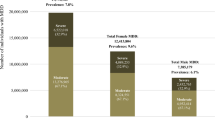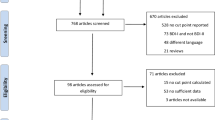Abstract
This study investigated changes in depression status over 2 years and examined whether having depression in Year 1 is associated with greater healthcare expenditures in Year 2 among community-dwelling older adults. This study analyzed the Medical Expenditure Panel Survey (Panel 13, 2008–2009) for a nationally representative sample of 1,740 older adults (65+). The two self-reported depression measures used were the ICD-9-CM (depression) and Patient Health Questionnaire-2 (potential depression, scores 3 or higher). Using the combined two-part models, additional healthcare costs at Year 2 associated with the Year 1 depression status were calculated by the service type after adjusting for predisposing, enabling, and need covariates assessed at Year 2. Over 7.9 % of older adults reported depression and an additional 6.5 % presented with potential depression. The ICD-9 depression status was relatively stable; 84 % continued reporting depression during Year 2. Those with depression at Year 1 spent $3,855 more on total healthcare, $1,053 more on office-based visits, and $929 more on prescription drugs during Year 2 compared with non-depressed people after controlling for other covariates, including healthcare needs (p < .05). While potential depression was less persistent (31.1 % remained potentially depressed at Year 2), potential depression was associated with lower socio-economic status and greater healthcare expenditures from home health services and emergency department visits during Year 2. These results indicate the importance of monitoring depression in older adults, considering its impacts on the increases in healthcare expenditures in the following year even after controlling for co-occurring health conditions.
Similar content being viewed by others
References
Zivin K, Llewellyn DJ, Lang IA, et al.: Depression among older adults in the United States and England. The American Journal of Geriatric Psychiatry 18:1036–1044, 2010.
Moussavi S, Chatterji S, Verdes E, Tandon A, Patel V, Ustun B.: Depression, chronic diseases, and decrements in health: Results from the World Health Surveys. Lancet 370:851–858, 2007.
Heisel MJ, Duberstein PR: Suicide prevention in older adults Clinical Psychology: Science and Practice 12:242–259, 2005.
Adamson JA, Price GM, Breeze E, Bulpitt CJ, Fletcher AE: Are older people dying of depression? Findings from the medical research council trial of the assessment and management of older people in the community. Journal of the American Geriatrics Society 53:1128–1132, 2005.
Evans DL, Charney DS, Lewis L, et al.: Mood disorders in the medically ill: Scientific review and recommendations. Biological Psychiatry 58:175–189, 2005.
Unützer J, Schoenbaum M, Katon WJ, et al.: Healthcare costs associated with depression in medically ill fee-for-service medicare participants. Journal of the American Geriatrics Society 57:506–510, 2009.
Harman JS, Kelleher KJ, Reynolds CF, Pincus HA: Out-of-pocket healthcare expenditures of older Americans with depression. Journal of the American Geriatrics Society 52:809–813, 2004.
Morrow-Howell N, Proctor E, Choi S, et al.: Depression in public community long-term care: Implications for intervention development. The Journal of Behavioral Health Services & Research 35:37–51, 2008.
Penninx BW, Deeg DJ, van Eijk JT, Beekman AT, Guralnik JM: Changes in depression and physical decline in older adults: A longitudinal perspective. Journal of Affective Disorders 61:1–12, 2000.
Jacob V, Chattopadhyay SK, Sipe TA, Thota AB, Byard GJ, Chapman DP: Economics of collaborative care for management of depressive disorders: A community guide systematic review. American Journal of Preventive Medicine 42:539–549, 2012.
Katon W, Russo J, Lin EB, et al.: Cost-effectiveness of a multicondition collaborative care intervention: A randomized controlled trial. Archives of General Psychiatry 69:506–514, 2012.
Unützer J, Katon WJ, Fan MY, et al.: Long-term cost effects of collaborative care for late-life depression. The American Journal of Managed Care 14:95–100, 2008.
Katon WJ, Russo JE, Von Korff M, Lin EH, Ludman E, Ciechanowski PS: Long-term effects on medical costs of improving depression outcomes in patients with depression and diabetes. Diabetes Care 31:1155–1159, 2008.
Choi S, Lee S, Matejkowski J, Baek YM: The relationships among depression, physical health conditions and healthcare expenditures for younger and older Americans. Journal of Mental Health 23:140–145, 2014.
Katon WJ, Lin E, Russo J, Unützer J: Increased medical costs of a population-based sample of depressed geriatric patients Archives of General Psychiatry 60:897–903, 2003.
Lee BW, Conwell Y, Shah MN, Barker WH, Delavan RL, Friedman B: Major depression and emergency medical services utilization in community-dwelling elderly persons with disabilities International Journal of Geriatric Psychiatry 23:1276–1282, 2008.
Luber MP, Meyers BS, Williams-Russo PG, et al.: Depression and service utilization in geriatric primary care patients. The American Journal of Geriatric Psychiatry 9:169–176, 2001.
Beekman AF, Geerlings SW, Deeg DH, et al.: The natural history of late-life depression: A 6-year prospective study in the community. Archives of General Psychiatry 59:605–611, 2002.
Licht-Strunk E, van der Windt D, van Marwijk H, de Haan M, Beekman A: The prognosis of depression in older patients in general practice and the community. A systematic review. Family Practice 24:168–180, 2007.
Arroll B, Goodyear-Smith F, Crengle S, et al.: Validation of PHQ-2 and PHQ-9 to screen for major depression in the primary care population. The Annals of Family Medicine 8:348–353, 2010.
Harman JS, Edlund MJ, Fortney JC: Disparities in the adequacy of depression treatment in the United States. Psychiatric Services 55:1379–1385, 2004.
Andersen RM: Revisiting the behavioral model and access to medical access: Does it matter? Journal of Health and Social Behavior 36:1–10, 1995.
Gaskin DJ, Briesacher BA, Limcangco R, Brigantti BL: Exploring racial and ethnic disparities in prescription drug spending and use among Medicare beneficiaries. The American Journal of Geriatric Pharmacotherapy 4:96–111, 2006.
AHRQ: MEPS HC-130: Panel 13 Longitudinal Data File. Rockville, AHRQ, 2011.
AHRQ: Methodology Report #22: Sample Design of the Medical Expenditure Panel Survey Household Component, 1998–2007. Rockville, AHRQ, 2008.
AHRQ: MEPS HC-120: 2008 Medical Conditions. Rockville, AHRQ, 2010.
Egede LE, Zheng D, Simpson K: Comorbid depression is associated with increased health care use and expenditures in individuals with diabetes. Diabetes Care 25:464–470, 2002.
Chung S: Does the use of SSRIs reduce medical care utilization and expenditures? The Journal of Mental Health Policy and Economics 8:119–129, 2005.
Kroenke K, Spitzer RL, Williams JB: The Patient Health Questionnaire-2: Validity of a two-item depression screener. Medical Care 41:1284–1292, 2003.
Newacheck PW, Infelas M, Kim SE: Health services use and health care expenditures for children with disabilities. Pediatrics 114:79–85, 2004.
Mohanty SA, Woolhandler S, Himmelstein DU, Pati S, Carrasquillo O, Bor DH: Health care expenditures of immigrants in the United States: A nationally representative analysis. American Journal of Public Health 95:1431–1438, 2005.
Banthin J, Bernard D: Out-of-pocket expenditures on health care and insurance premiums among the elderly population, 2003. Rockville, Agency for Healthcare Research and Quality, 2006.
Belotti F, Deb P, Manning WG, Norton EC: TPM: Estimating two-part models. The Stata Journal 20:1–13, 2012.
Buntin MB, Zaslavsky AM: Too much ado about two-part models and transformation? Comparing methods of modeling Medicare expenditures. Journal of Health Economics 23:525–542, 2004.
Manning WG, Mullahy J: Estimating log models: To transform or not to transform?. Journal of Health Economics 20:461–494, 2001.
Stata Press: STATA Reference Manual: Survey Data. College Station, Stata Press, 2007.
Institute of Medicine: The Mental Health and Substance Use Workforce for Older Adults: In Whose Hands? Washington, The National Academies Press, 2012.
Lurie IZ, Manheum LM, Dunlop DD: Differences in medical care expenditures for adults with depression compared to adults with major chronic conditions. The Journal of Mental Health Policy and Economics 12:87–95, 2009.
Katon WJ: Clinical and health services relationships between major depression, depressive symptoms, and general medical illness. Biological Psychiatry 54:216–226, 2003.
Patten SB, Williams J, Lavorato DH, Modgill G, Jetté N, Eliasziw M: Major depression as a risk factor for chronic disease incidence: Longitudinal analyses in a general population cohort. General Hospital Psychiatry 30:407–413, 2008.
Druss BG, Walker ER: Mental Disorders and Medical Comorbidity. Princeton, Robert Wood Johnson Foundation, 2011.
Ciechanowski PS, Katon WJ, Russo JE: Depression and diabetes: Impact of depressive symptoms on adherence, function, and costs. Archives of Internal Medicine 160:3278–3285, 2000.
Finkelstein EA, Bray JW, Chen H, et al.: Prevalence and costs of major depression among elderly claimants with diabetes. Diabetes Care 26:415–420, 2003.
Beekman ATF, Penninx BWJH, Ormel DJ, Braam AW, Tilburg W: Depression and physical health in later life: Results from the Longitudinal Aging Study Amsterdam (LASA). Journal of Affective Disorders 46:219–231, 1997.
Lee M, Hasche LK, Choi S, Proctor E, Morrow-Howell N: Comparison of major depressive disorder and subthreshold depression among older adults in community long-term care. Aging & Mental Health 17:461–469, 2013.
Lynnes JM, Kim J, Tang W, et al.: The clinical significance of subsyndromal depression in older primary care patients. The American Journal of Geriatric Psychiatry 15:214–223, 2007.
Hybels CF, Blazer DG, Pieper CF: Toward a threshold of subthreshold depression: Analysis of correlates of depression severity of symptoms using data from an elderly community sample. The Gerontologist 41:357–365, 2001.
Nguyen D, Vu CM: Current depression interventions for older adults: A review of service delivery approaches in primary care, home-based, and community-based settings. Current Translational Geriatrics & Experimental Gerontology Reports 2:37–44, 2013.
Hasche L, Morrow-Howell N: Depression. In: Blackburn JA, Dulmus CN (Eds) Handbook of Gerontology: Evidence-Based Approaches to Theory, Practice, and Policy. Hoboken, John Wiley & Sons Inc., pp. 269–308, 2007.
Quijano LM, Stanley MA, Petersen NJ, et al.: Healthy IDEAS: A depression intervention delivered by community-based case managers serving older adults. Journal of Applied Gerontology 26:139–156, 2007.
Bao Y, Alexopoulos GS, Casalino LP, et al.: Collaborative depression care management and disparities in depression treatment and outcomes. Archives of General Psychiatry 68:627–636, 2011.
Kilo CM, Wasson JH: Practice redesign and the patient-centered medical home: History, promises, and challenges. Health Affairs (Millwood) 29:773–778, 2010.
Rosenthal TC: The medical home: Growing evidence to support a new approach to primary care. The Journal of the American Board of Family Medicine 21:427–440, 2008.
Bojadzievski T, Gabbay RA: Patient-centered medical home and diabetes. Diabetes Care 34:1047–1053, 2011.
Kessler RC, Berglund P, Demler O, et al.: The epidemiology of major depressive disorder: Results from the national comorbidity survey replication (ncs-r). JAMA: The Journal of the American Medical Association 289:3095–3105, 2003.
Acknowledgments
This study was supported by the John A. Hartford Foundation and the Gerontological Society of America through the Hartford Geriatric Social Work Faculty Scholars Program.
Conflict of interest
All authors declare that they have no conflict of interest.
Author information
Authors and Affiliations
Corresponding author
Rights and permissions
About this article
Cite this article
Choi, S., Hasche, L. & Nguyen, D. Effects of Depression on the Subsequent Year’s Healthcare Expenditures Among Older Adults: Two-Year Panel Study. Psychiatr Q 86, 225–241 (2015). https://doi.org/10.1007/s11126-014-9324-4
Published:
Issue Date:
DOI: https://doi.org/10.1007/s11126-014-9324-4




